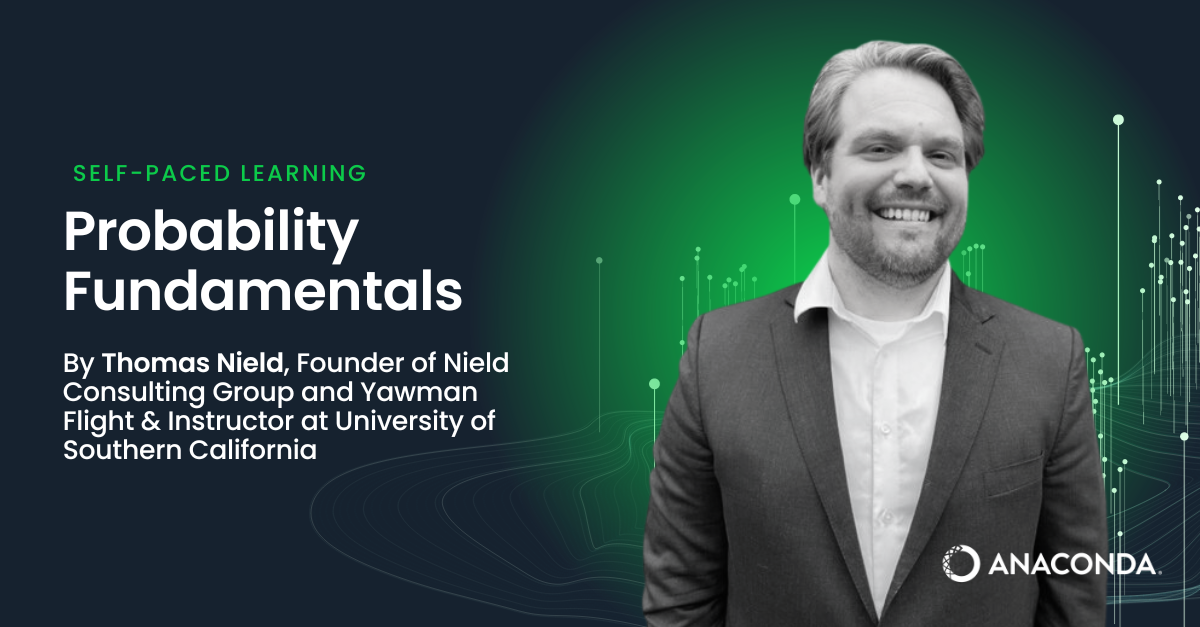- Getting Started
-
How to use Anaconda Notebooks
-
Course Overview and Learning Objectives
- Probability Axioms and Definitions
-
What is Probability?
-
Percentages and Odds
-
Joint Probability
-
Union Probability
-
Conditional Probability
-
Exercise: Airline Delays
- Bayes Theorem
-
Overview and Formula
-
Understanding Bayes Theorem
-
Bayes Theorem and Confusion Matrices
-
Normalizing Constant
-
Exercise: Smart Car Diagnostics
- Discrete Probability Distributions
-
Bernoulli Distribution
-
Binomial Distribution
-
Multinomial Distribution
-
Poisson Distribution
-
Exercise: Coin Flips
- Continuous Probability Distributions
-
Normal Distribution
-
Exponential Distribution
-
Beta Distribution
-
Exercise: Beans in a Cup of Coffee
- Monte Carlo Simulations
-
Monty Hall Problem
-
Generating Values from Distributions
-
Customer Queue Simulation
-
Exercise: Elevator Weight Limit Simulation
- Maximum Likelihood Estimation
-
Fitting a Normal Distribution
-
Using MLE to Fit a Linear Regression
-
Exercise: Calculate the MLE for a Dataset
- Conclusion
-
Summary and Further Reading Resources
-
End of Course Survey

Probability Fundamentals
Measuring uncertainty for data science.
Probability is the most fundamental building block in data science, machine learning, and statistical modeling. Measuring uncertainty is how we approximate whether something will happen or not, which is pivotal when creating interesting and useful models. Given the common misconceptions surrounding probability, establishing a solid understanding of both its theory and practical applications is imperative.
In this hands-on course, you’ll learn how to work with probability and explore critical concepts, such as Bayes’ theorem and probability distributions. You’ll also build useful applications, ranging from simulating elevator capacity, tracking airline delays, and fitting regressions using maximum likelihood.
By the end of this hands-on course, you’ll understand:
- How probability plays a role in machine learning and data science
- Bayes’ theorem and its relevance in everyday statistics
- Discrete and continuous probability distributions and the problems they apply to
And you’ll be able to:
- Build simple probability-based simulations
- Fit regressions using probability concepts
- Apply the SciPy Python package to build probability distributions
This training is for you because...
- You’re a data science professional looking to better understand probability concepts.
- You work with statisticians who use tools like probability distributions and simulations.
- You wish to become a better machine learning practitioner by understanding probability’s role in machine learning.
Prerequisites
- Proficiency with basic Python operations, including variables, loops, collections, functions, and other basic operations.
Setup
To open Anaconda Notebooks:
- Go to https://anaconda.cloud
- Click on 'Notebooks' from the top navigation menu
- Create an account or login if you already have one
Recommended preparation
- Introduction to Python Programming learning path
Recommended follow-up
- Statistics and Hypothesis Testing on-demand course
- Linear Algebra on-demand course
- Introduction to Machine Learning on-demand course
Facilitator bio
Thomas Nield is the founder of Nield Consulting Group and Yawman Flight, as well as an instructor at University of Southern California. He enjoys making technical content relatable and relevant to those unfamiliar or intimidated by it. Thomas regularly teaches classes on data analysis, machine learning, mathematical optimization, and practical artificial intelligence. At USC, he teaches AI System Safety, developing systematic approaches for identifying AI-related hazards in aviation and ground vehicles. He's authored three books, including Essential Math for Data Science (O’Reilly) and Getting Started with SQL (O'Reilly).
He is also the founder and inventor of Yawman Flight, a company developing universal handheld flight controls for flight simulation and unmanned aerial vehicles. You can find him on Twitter | LinkedIn | GitHub | YouTube.
Questions? Issues? Contact [email protected].



